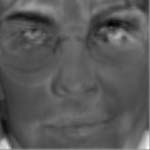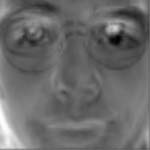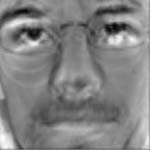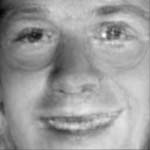Amir Akbarzadeh - Project 4, CSE 455 Winter 2003
Some results
The eigenfaces created from class images and the undergraduate images
along with the average faces for these sets.
Notice that since I did the 2 bell credit (computing eigenfaces faster) I
was enabled to compute very large eigenfaces very quickly.
Average face and eigenfaces created from class_nonsmiling_cropped (notice
that I have removed the normalizing (after grayscale conversion) of the
loaded images, since increasing the contrast for every image doesn't seem
like a good idea, specially when we want to see if things are faces or not,
normalizing will make the variance of e.g. "all shirt" areas
larger which we don't want specially in findface, I changed image.subimage
as well) anyways this makes my eigenfaces look a little bit different:








Average face and eigenfaces created from ugrads_cropped:








Some examples of image recognition attempts that failed (if there were
any) and some that succeeded.
Using 12 150 by 150 eigenfaces built from class_nonsmiling_cropped
paullarp was mistaken to be alissah:






smiling
paullarp
proj. smil. paullarp proj.
nonsmil. alissah nonsmiling
alissah nonsmiling
paullarp proj.
nonsmil. paullarp
Looking at the projected images of smiling paullarp and nonsmiling
alissah they sure look a like, however projected nonsmiling paullarp doesn't
look to different either, which explains why paullarp was the second best
match (notice that above, in question/answer part, when smaller eigenfaces
where used paullarp was the 3:rd best match of himself)
Your two images showing the results of face detection
Friends, min_scale = 0.55, max_scale = 0.6, step = 0.05, Famous, min_scale
= 0.8, max_scale = 0.91, step = 0.05


Some results of successful and unsuccessful automatic image cropping
attempts




Questions and Answers:
Testing recognition with cropped class images
Procedure
- Use the cropped, non-smiling students (in class_nonsmiling_cropped) to
compute 7 eigenfaces.
- Use the same set of images to compute a userbase.
- Have the program recognize the cropped, smiling student images (in
class_smiling_cropped) in the smiling userbase.
Questions
- How many faces did the program recognize correctly? Incorrectly?
- For instances where the program was wrong, what was the average position
of the correct answer in the list of closest matches?
- If you recognize a female face, will the second, third and fourth
matches usually be female? How about for male faces? Give supporting data.
- In a real-life scenario with thousands of users would you use the entire
user set to compute the face space? Why or why not?
- Why might it be better to use a face set independent of the user set to
compute the eigenfaces?
Answers
- 17 correct, 5 incorrect
- 2-3
- yes, females usually follow by females, equiv. for males, but not always:
Face 'class_smiling_cropped\rhennig.tga' recognized as being closest too:
0: class_nonsmiling_cropped\mbixby; MSE: 142640
1: class_nonsmiling_cropped\rhennig; MSE: 146351
Face 'class_smiling_cropped\mhl.tga' recognized as being closest too:
0: class_nonsmiling_cropped\melissa; MSE: 342233
1: class_nonsmiling_cropped\mhl; MSE: 348104
however we
also have:
Face 'class_smiling_cropped\paullarp.tga' recognized as being closest too:
0: class_nonsmiling_cropped\alissah; MSE: 106214
1: class_nonsmiling_cropped\ddewey; MSE: 167364
2: class_nonsmiling_cropped\paullarp; MSE: 237571
- What would be good to do is that take users that are different, e.g. have
different skin color, gender etc. In this way the spanned face space won't
be biased towards a certain group of people
- If the eigenfaces are computed from the user set then it is a greater
chance that when reconstructing faces that are not in the user set the face
will end up looking like a user and being recognized as someone in the user
set, this is bad if for example a company uses face recognition for security
reasons, letting people in to the building etc.
Recognizing the undergraduate faces
Procedure
- Use the cropped undergraduate students (in ugrads_cropped) to compute 12
eigenfaces.
- Use the small set of class undergraduate images (in class_ugrads_cropped)
to compute a userbase.
- Have the program recognize the cropped, non-smiling student images in this
userbase.
- Repeat your experimentation with 5, 10, 15, and 20 eigenfaces. Remember to
regenerate the userbase each time.
- Why is it best to use as few eigenfaces as possible while still getting
good results?
Questions
- Of the students in the class set who are also in the class undergraduate
set, how many did the program recognize correctly? Incorrectly?
- Are the incorrect identifications reasonable? Do they look similar to the
actual person? Give some example images.
- Why does the program perform more poorly in this recognition task than the
previous one? Give at least three reasons.
- How did changing the number of eigenfaces used change your results? What
number worked best?
Answers
- 15 incorrect, 2 correct
- No they are not reasonable, using 12 100 by 100 pixels eigenfaces, I got
most of the people being recognized as mbixby (and 3 other persons), this is
a bit weird, looking at mbixby's picture the only thing special for him is
that his face is very light.
- The faces used to construct the eigenfaces and the userbase where
photographed under very different lighting conditions compared to the
class_nonsmiling pictures. The face "rotations" where different
comparing class_ugrads with class_nonsmiling. Some people wore glasses in
one set and not in the other. Also the fact that the faces where at
different sizes might also have an effect on the result.
- It hardly changed the result at all. For recognition using smaller number
of eigenfaces is better. The reason is: when comparing two faces we are
comparing the faces coefficients in face space, the difference between two
faces lies mostly in the coefficients in front of the eigenfaces with
highest eigenvalue, the coefficients in front of the eigenfaces with lower
eigenvalues will not differ much between different faces, so bringing them
in will only make the difference less, since we are dividing the difference
between the coefficient vectors with the length of the coefficient vector.
Cropping the undergraduate faces
- Use the eigenfaces file computed in the previous problem
- Use your program to crop at least ten of the uncropped undergraduate
images
- Experiment with min_scale, max_scale, and step parameters to find ones
that work robustly and accurately without taking more than 10 seconds or so
to run on each image
Questions
- What min_scale, max_scale, and scale step did you end up using?
- How many of your crop results look correct (cropped to the same part of
the face as the pre-cropped images)? How many look incorrect?
- What is the problem with using a min_scale that is too small?
Answers
- min_scale = 0.18, max_scale = 0.20, step = 0.01
- 6 correct, 4 incorrect
- The details building up the face are lost
Finding faces in a group photo
Procedure
- Find two group photos, one of family or friends and one from the web of TV
or movie characters, or famous people. Each image should have at least four
faces.
- Use your program to find the faces in the photos (use the crop=false
option)
Questions
- Show the results of the face detections and what min_scale, max_scale, and scale_step did you use for each image?
- If there are any errors, explain why the program might have failed and how
you could improve the input or the algorithm to correct this.
Answers
- Friends, min_scale = 0.55, max_scale = 0.6, step = 0.05, Famous, min_scale
= 0.8, max_scale = 0.91, step = 0.05


- Since one face is very fuzzy the algorithm chooses the second best thing,
being an all same color area, the algorithm has already been adjusted to
handle this error, however since we force it to find 5 faces, the all same
color area is still better than the other things.

































